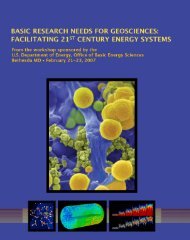Measurement Science Roadmap for Net-Zero Energy Buildings
Measurement Science Roadmap for Net-Zero Energy Buildings
Measurement Science Roadmap for Net-Zero Energy Buildings
- No tags were found...
Create successful ePaper yourself
Turn your PDF publications into a flip-book with our unique Google optimized e-Paper software.
Mid Term: CO2, CO, VOC andparticulate-sensing needs to be lowcost,accurate, low-maintenance, andwireless. “Micro-sensing”—wireless,low-cost measuring of temperature,RH, etc.—would facilitate automatedfault detection, diagnostics, andcommissioning <strong>for</strong> fine-tuningsubsystems energy use.Long Term: Demand- andper<strong>for</strong>mance-based controls <strong>for</strong> allindoor environmental qualityparameters (e.g., light, thermal, indoorair quality (IAQ)) ensure no wastedenergy. Expanded use of BuildingIn<strong>for</strong>mation Modeling (BIM) allows <strong>for</strong>more detailed analysis of potentialsystems. An intuitive, TurboTax-likeuser-interface <strong>for</strong> design could <strong>for</strong>m the basis of design metrics⎯particularly inconcept development.Indoor Air QualityMid Term: Passive air-cleaning technologies need to be developed. IndividualbasedHVAC would reduce energy demand <strong>for</strong> maintaining air quality. Low-costself-cleaning filters are also necessary.Long Term: Whole building IAQ design must be an integral part of the wholebuilding system.C. Broad ChallengesCommercial building systems control panel.(Photo: MS Online)Technical ChallengesDesign and systems integration is a key issue in the implementation of wholebuilding concepts. Lack of integration between design, analysis, and operation isone of the most critical barriers. In general, there is a lack of data, in<strong>for</strong>mation,and education related to the use of integrated building design. Overly complexdesign and construction and under-developed quality management systems bothcontribute to making integration more difficult. The current architectural focus ison space and <strong>for</strong>m, not on human per<strong>for</strong>mance⎯but the integration of both isnecessary <strong>for</strong> effective whole building designs. Lack of user-friendly, detailedmodels in the design phase is also an impediment. Another major barrier is thatbuilding occupants do not account <strong>for</strong> building life cycle costs because they movefrequently.Building per<strong>for</strong>mance monitoring and control is vital to whole building integratedper<strong>for</strong>mance and faces a number of challenges. Validation of energy cost savingswith real data, not model predictions, is a major barrier. Useful (i.e., measurable,quantitative, and meaningful) criteria <strong>for</strong> IAQ control is also lacking, making it38 <strong>Measurement</strong> <strong>Science</strong> <strong>for</strong> <strong>Net</strong>-<strong>Zero</strong> <strong>Energy</strong> <strong>Buildings</strong>
















